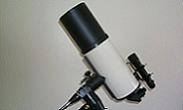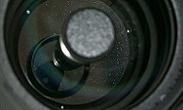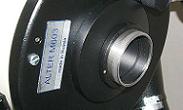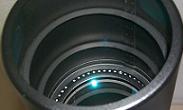
Reviews > Telescopes > Intes Micro Alter-M603

I write this review in the hope that it may prove useful to anyone considering purchasing an Intes-Micro Alter M603. In the summer of 2004 I spent the majority of my evenings reading similar reviews in order to acquire as much useful knowledge as possible to allow me to make the right decision. One of the first things I realised was that the elusive perfect telescope does not in fact exist (at least not within my budget). Each style of telescope tends to be a compromise between portability, aperture, cost and performance. Before I start the review I should mention that I have been interested in astronomy for about 15 years. I bought my first telescope at the age of 11 years. It was a Tasco 60mm refractor and I spent many evenings of my childhood in my back garden in England, UK staring up at the heavens. Many people I have spoken to are all too quick to discard this telescope as a mere toy rather than an instrument suitable for amateur astronomers. However, it was this telescope which delivered to me my first views of the craters on the Moon and rings of Saturn in such a way as to retain my interest ever since. I have often taken great pleasure in showing these celestial bodies to family and friends and watching their response. They were almost always awe struck and wanted to see more. This is the main reason I wanted a new telescope. This telescope was far too small to see anything other than the brightest objects in any detail. So, after 15 years of carefully looking after this telescope I decided I would finally upgrade to something better.
Firstly I would like to mention the decision process I went through before eventually deciding upon the Intes-Micro Alter M603. As I mentioned before, my previous telescope was a 60mm refractor. I am quite familiar with refractors and in fact these are the only telescopes I have ever used. The predominant reasons I preferred refractors were because they tend to offer the highest contrast views of all types of telescope, they rarely require collimation and there is no need for mirrors to be re-coated after several years. I had set myself a list of requirements for my new telescope. These were as follows:
- At least a 6 inch aperture.
- The scope should be portable.
- Planetary performance is of paramount importance.
- A budget of 1000 pounds sterling.
- Limited maintenance.
After browsing the websites of various local suppliers of astronomy equipment I soon found the Celestron C6-R. This is a 6 inch refractor at F8 at the price of 750 pounds. As it is a refractor it would require little maintenance and should perform well on the planets. For a couple of weeks I read as many websites as I could find to determine how owners felt about this scope. There were two major points that stuck in my mind. The Celestron C6-R is both large and (like all but the best refractors) suffers from some degree of chromatic aberration, especially at F8. Although the C6-R was my first choice, I had also noticed the Celestron C8-S. The C8-S is an 8 inch Schmidt Cassegrain. I decided to take a look around the local Celestron supplier s showroom. I was shocked to find out just how large the C6-R actually is. It is far too big to be portable and I would have trouble finding anywhere to keep it in the house without it becoming an inconvenience. As of this day my first choice became the C8-S either with or without the GOTO mount. This scope is more expensive, at about 1400 with GOTO, but I realised it would be worth paying a little extra to get something I would use more often.

For about a month I researched the C8 reading countless reviews on the Internet. It s a very popular scope and there is no shortage of information out there. Originally I had decided that GOTO would be a nice feature, or perhaps I was convinced by sales hype. However, after speaking with Chris Garvey at Bray Imaging I soon realised that GOTO isn t really a necessity. GOTO may help you find faint objects in the night sky, but it won t help you learn the sky and as far as I m concerned it would take some of the satisfaction away from actually finding something. Also, adding GOTO would mean spending money on electronics rather than what to me are the most important parts of the telescope; the optics and the mount. By the time I had realised I didn t want GOTO, I was also reconsidering whether the C8-S would be suitable. I realise there are many astronomers out there with a C8-S and they are extremely fond of it. I also know that they tend to be very variable in terms of quality. I wasn t happy with the idea of spending nearly 2000 pounds only to receive a telescope that may not be of the highest quality. The 8 inch aperture of the C8-S was certainly attractive, but I wasn t willing to pay this much money unless high quality optics were guaranteed. Once again, it was Chris Garvey of Bray Imaging that put me on the right track. He mentioned that the refractors offered by Teleskop Service (TS) are very good value and come with ronchigrams to confirm the quality of the optics. He also highly recommended the Intes and Intes-Micro line of Maksutov Cassegrains. The TS refractors suffer the same pitfalls as the Celestron C6-R. They are very large and suffer from chromatic aberration.
Following the conversation I had at Bray Imaging I decided to do some research into the Intes and Intes Micro Maks. I was quite pleased to read that most owners of equipment from these companies speak very highly of their telescopes and believe them to be excellent performers. The first model I looked at seriously was the Intes MK67 deluxe, a 6 inch Maksutov Cassegrain. The reviews I read confirmed that the scope possesses first class optics. It is highly portable and comes with its own padded case. The biggest drawback to the Maksutov Cassegrain design is that the thick meniscus lens takes some time to cool down when taken outside. This doesn t bother me too much because I can always take the scope outside to cool down several hours before I wish to use it. In my opinion the main drawback is the 2 inch Crayford focusser. It has a very limited travel range and might result in not being able to focus certain eyepieces. Purely for this reason I chose to look at the MK66 deluxe instead. The MK66 is very similar to the MK67 but has a moving primary mirror focusser instead of the Crayford focusser. However, the price difference between the MK66 deluxe and the Alter M603 is not great. The Alter series offered by Intes-Micro is generally considered to be of higher quality, so I eventually opted for the Alter M603. It meets all my original requirements and judging by the reviews I should be pleased with the quality of the optics. One of the reasons I have chosen to write this review is that there is a limited amount of information available on the Internet about the Intes-Micro Alter M603.

I finally received my new Alter M603 at the end of August 2004. It arrived in a soft padded case into which the 12x55 finderscope and 2" star diagonal easily fit. It also came with a 2.4x Barlow lens and a 12mm eyepiece. I bought a dewshield, a Helios EQ-5 mount and a set of TS eyepieces separately. The first thing I noticed about the M603 is that it has very few markings. It also looks a little different to the photos shown on the other reviews I have seen. All other reviews I have read show the M603 to have a body that is completely creamy-white. My M603 is also creamy-white, but the section near the eyepiece opening is matt black. This section includes the only label on the whole telescope that reads 'ALTER M603 made in Russia'.
The finderscope adjustment screws have nylon tips to prevent them from damaging the finderscope. It has been said that if you drop one of these scopes you should worry more about your feet than the scope. I don t want to test the theory, but I can see why it might have been said. It looks and feels like a very robust piece of equipment. The Intes-Micro 2 inch star diagonal is of equally robust appearance and there is no play whatsoever in the joints. To my dismay I noticed the star diagonal mirror and 12mm eyepiece were covered with a number of dust/dirt particles, as was the meniscus lens of the scope when very carefully inspected. I realise it s difficult to keep optics dust free, but it would have been nice to have received them in pristine condition.

The scope looks and feels quite heavy. There are no plastic parts visible, pleasingly it is a lump of glass and metal. A dovetail rail is attached to the underside of the scope which runs along the entire length and fits directly to the mount. The finderscope bracket and camera piggy back bracket can both be left on and still fit inside the case. I have no reserves about the build quality of this scope, but I do have two concerns. The eyepiece isn t labelled at all, so if I didn t know it was a 12mm eyepiece it could get a little confusing. Also, the star diagonal attaches to the scope by means of a screw on adapter. I ve often found that screwing this on in the dark is a little difficult and I m concerned that I could end up cross threading the adapter. The advantage of the 2 inch threaded adapter is that it is compatible with the large variety of accessories produced for popular SCT s.
The telescope is very well baffled, even the dew shield has baffling. The dew shield pushes onto the front of the scope, and is secured by tightening three plastic screws (the only plastic parts on the whole scope!).

Having only previously owned a small refractor, I have never needed to learn how to check collimation before. I ve since read some very good articles on the Internet and have checked the collimation by both eyeballing and performing a star test. Both tests showed that the scope seems to be well collimated. I m a perfectionist and I m sure I will end up tweaking it further before long. One of the points I should mention about the M603 is that both the primary and secondary mirrors can be adjusted. As I write this review I haven t been able to test the scope with the TS eyepieces. I received them a couple of days ago, but due to the poor weather often associated with England, I haven t been able to put them to any use. I have been able to test the scope with the 12mm Intes-Micro eyepiece that comes as standard. The eyepiece has a 70mm apparent FOV which I have found has a slight amount of coma at the edges. The field of view does make finding objects quite easy though. I ve been using the M603 over the past two weeks, weather permitting, and I have been consistently pleased with the views. My 60mm refractor was never able to show me globular clusters, galaxies and nebulas as anything more than a faint smudge in the eyepiece. The M603 resolved M13 into individual stars with the 12mm eyepiece. The 1500mm focal length is effectively extended to 1725mm with the 2 inch star diagonal attached, which means the 12mm eyepiece provides an effective 144x magnification. That s a lot higher than I would normally use to view deep sky objects, but in the absence of alternatives it works well.

The double-double can be identified as four stars on a night of average seeing with the 12mm eyepiece, although the 2.4x Barlow clears up any element of doubt by further separating the stars. M57 is easily visible as a ring with a faint centre, though the central star is of course not visible with the 6 inch aperture. What I have noticed is that this scope is very good at showing globular clusters. Although the Andromeda Galaxy M31 is fairly bright in comparison to most globular clusters, I have found that the M603 just doesn t seem to do it justice. I m unable to resolve stars here and I only ever see a bright haze on even the darkest nights and those of best seeing. The moon at 46% phase (waning gibbous) showed remarkable crater detail along the terminator.

I ve discovered that the scope takes a good hour and a half to cool down properly. The easiest way to determine if the scope has cooled down is to perform a star test on Vega, or any other conveniently located bright star. If the star is shown out of focus so as to display its diffraction rings, there will be a marked shimmering in the rings if either the atmosphere is unsteady or if the scope is cooling down. If the atmosphere is unsteady the rings will appear to shimmer rapidly. If the scope is cooling down the shimmering is much slower and appears almost as though water were flowing over the image. I have noticed that the flowing water effect is most noticeable on one side of the image. Apparently this is because the heat leaves the primary mirror from the edge facing upwards.
In conclusion, I m very pleased with the optical and mechanical quality of this scope. I ve seen deep sky objects in a detail I ve never before seen, and I never really intended to use the scope for deep sky observations. The cool down period is quite significant and requires planning, but shouldn t be considered a disadvantage unless you are the type of person that prefers to observe at a moments notice. I highly recommend this scope for its high contrast performance and solid build. However, for deep sky observers something with a larger aperture may be preferable.
Finally, I would like to extend my thanks to Chris Garvey for all the advice he gave, and to Tim Ryan of House of Optics for going out of his way to deliver the scope to me several weeks ago. Also, I would like to thank my wife for her patience throughout the months of research and for putting up with listening to me tell her all of these details every morning on the way to work. A true star!